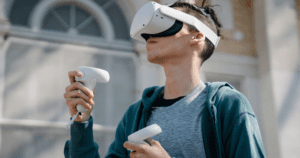Resources
The Impact of AR/VR in Mobile Applications

In the digital age, the quest for more immersive and engaging user experiences is relentless. Augmented Reality (AR) and Virtual Reality (VR) technologies are at the forefront of this revolution, transforming the way users interact with mobile applications. From enhancing everyday tasks to creating unparalleled digital worlds, AR and VR are redefining the boundaries of mobile app capabilities. In this exploration, we delve into how these technologies are shaping the future of mobile app development and the user experience.
The Rise of AR and VR in Mobile Apps:
The integration of AR and VR into mobile apps is not just a trend; it’s a substantial shift in user interaction and engagement. AR brings digital elements into the real world, enhancing the way we shop, learn, and connect. VR, on the other hand, transports users into entirely virtual environments, offering unprecedented levels of immersion. This evolution in app development is creating new opportunities for businesses and developers alike to captivate their audiences in ways previously unimaginable.

Enhancing User Experience with AR:
AR technology in mobile apps has opened up a new realm of possibilities for enhancing user experience. Retail apps, for example, leverage AR to allow customers to visualize products in their own space before making a purchase decision. Educational apps use AR to bring complex concepts to life, making learning more interactive and engaging. These applications of AR not only elevate the user experience but also add significant value to the functionality of mobile apps.

Immersing Users with VR:
VR takes user engagement to a whole new level by offering immersive experiences that are both captivating and interactive. Gaming apps have been pioneers in utilizing VR, creating virtual worlds that offer an escape from reality. However, the potential of VR extends far beyond gaming. For instance, travel apps can offer virtual tours of distant locations, and meditation apps can transport users to serene environments, enhancing the effectiveness of their practices.

The Challenges and Opportunities:
Integrating AR and VR into mobile apps comes with its set of challenges, including high development costs, technological limitations, and user accessibility issues. However, the opportunities far outweigh these challenges. By overcoming these obstacles, developers can create more engaging, useful, and innovative apps that stand out in a crowded market. The key lies in understanding the specific needs and preferences of the target audience and leveraging AR and VR technologies to meet these demands creatively.

Future Trends in AR/VR Mobile Apps:
As AR and VR technologies continue to evolve, we can anticipate a future where their integration into mobile apps becomes more seamless and accessible. Advances in hardware and software will lower the barriers to entry, enabling a wider range of applications across various industries. Furthermore, as 5G technology becomes more widespread, the enhanced connectivity will allow for more complex and interactive

The integration of AR and VR technologies is transforming the landscape of mobile app development, offering new ways to engage and delight users. By harnessing the power of these technologies, developers can create unparalleled user experiences that are immersive, interactive, and deeply engaging. As we look to the future, the possibilities for AR and VR in mobile apps are as limitless as our imagination, promising a new era of digital interaction that blurs the lines between the virtual and the real world.